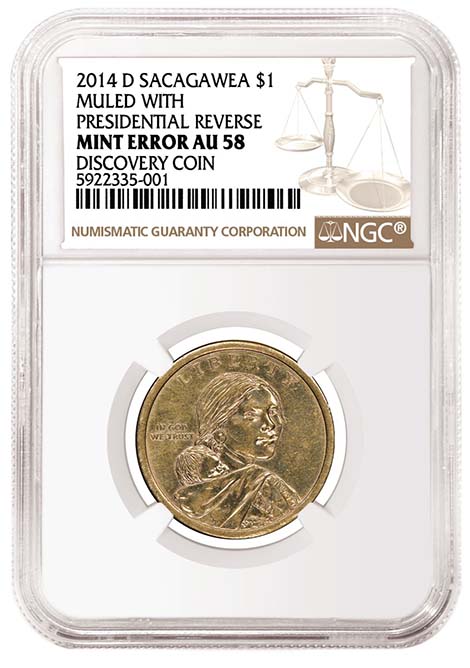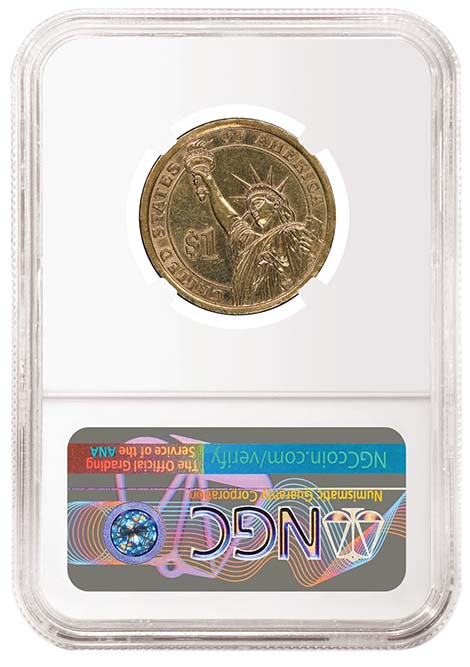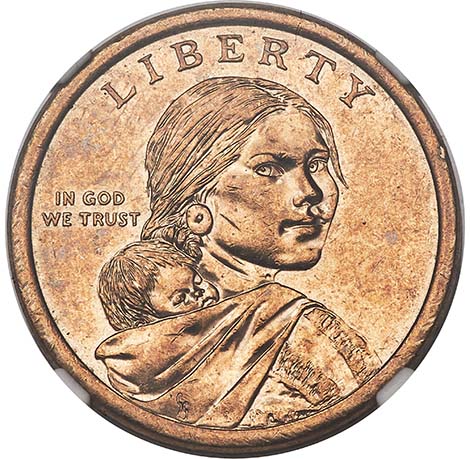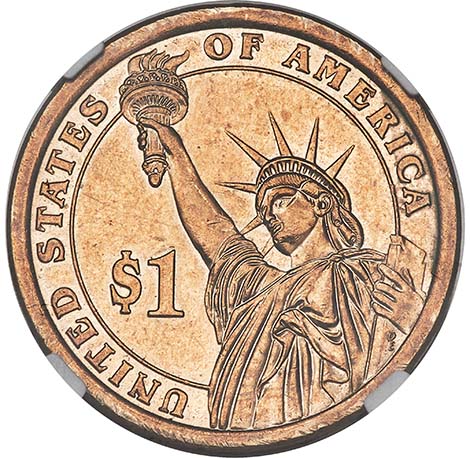The following coin sold for $84,000 in the April 2021
Central States US Coins Signature Auction #1329.
2014-D Sacagawea/Presidential Dollar Mule
Previously Unknown Mint Error
The Discovery Coin, AU58
 A mule is perhaps the most fascinating mint error known to modern collectors. Most error types, such as off-center strikes, brockages, indents, die caps, wrong planchets, etc., are the product of some part of the mechanical coin production line failing to function as normal. Many such errors are the statistically inevitable result of striking hundreds of millions of coins per year through a single set of presses. Others are so fantastic that it would be illogical not to accept the idea that they had "help" getting out of the Mint. Mules, on the other hand, are an error of their own breed. Broadly speaking, a mule is a coin struck from two dies that were never meant to be paired. Rather than the product of mechanical failings, as are most modern mint errors, mules are the product of human error.
A mule is perhaps the most fascinating mint error known to modern collectors. Most error types, such as off-center strikes, brockages, indents, die caps, wrong planchets, etc., are the product of some part of the mechanical coin production line failing to function as normal. Many such errors are the statistically inevitable result of striking hundreds of millions of coins per year through a single set of presses. Others are so fantastic that it would be illogical not to accept the idea that they had "help" getting out of the Mint. Mules, on the other hand, are an error of their own breed. Broadly speaking, a mule is a coin struck from two dies that were never meant to be paired. Rather than the product of mechanical failings, as are most modern mint errors, mules are the product of human error.
 Instances of this in the latter half of the 19th century were the product of questionable Mint employee practices to profit from the sale of such coins to outside collectors. In modern times, though, mules are actual errors, and the instances of coinage are rare. Perhaps the most famous mule coin in American numismatics is the famous Sacagawea dollar/Washington quarter mule struck at Philadelphia in the year 2000. Less than 20 examples of the error are known, and whenever one appears at auction, a spirited bidding war and six-figure hammer price are virtual certainties. Those double-denomination mules are considered to be one of if not the greatest modern coins in United States numismatics, error or otherwise.
Instances of this in the latter half of the 19th century were the product of questionable Mint employee practices to profit from the sale of such coins to outside collectors. In modern times, though, mules are actual errors, and the instances of coinage are rare. Perhaps the most famous mule coin in American numismatics is the famous Sacagawea dollar/Washington quarter mule struck at Philadelphia in the year 2000. Less than 20 examples of the error are known, and whenever one appears at auction, a spirited bidding war and six-figure hammer price are virtual certainties. Those double-denomination mules are considered to be one of if not the greatest modern coins in United States numismatics, error or otherwise.
 The present lot is in the same class as those pieces, but being thus far unique, it stands apart on its own ground as well. The obverse is from an ordinary 2014-D Sacagawea dollar, but the reverse is that intended for the Presidential dollars of that year. A pressman at the Mint, when changing out the dies on one of the presses, inadvertently selected a Presidential dollar reverse rather than the appropriate Native Hospitality reverse. The mistake was likely noticed shortly after the press resumed operation, and Mint practice would have been to destroy all of the affected coins. This piece evidently fell through the cracks and escaped the Mint in a bag with ordinary Sacagawea dollars.
The present lot is in the same class as those pieces, but being thus far unique, it stands apart on its own ground as well. The obverse is from an ordinary 2014-D Sacagawea dollar, but the reverse is that intended for the Presidential dollars of that year. A pressman at the Mint, when changing out the dies on one of the presses, inadvertently selected a Presidential dollar reverse rather than the appropriate Native Hospitality reverse. The mistake was likely noticed shortly after the press resumed operation, and Mint practice would have been to destroy all of the affected coins. This piece evidently fell through the cracks and escaped the Mint in a bag with ordinary Sacagawea dollars.
 The discovery of this piece took place in 2019, when it was found in a bag of mixed dollar coins obtained from a bank. It has the expected light abrasions and signs of high point friction that are to be expected of a circulation find, but satiny luster remains, and the significance of the coin vastly overshadows any regard to its grade. Coin World magazine publicized the discovery of this coin in a January 15, 2021 article by Bill Gibbs. Gibbs included a statement from David J. Camire, an NGC grading finalizer and coauthor of 100 Greatest U.S. Error Coins. Camire said:
The discovery of this piece took place in 2019, when it was found in a bag of mixed dollar coins obtained from a bank. It has the expected light abrasions and signs of high point friction that are to be expected of a circulation find, but satiny luster remains, and the significance of the coin vastly overshadows any regard to its grade. Coin World magazine publicized the discovery of this coin in a January 15, 2021 article by Bill Gibbs. Gibbs included a statement from David J. Camire, an NGC grading finalizer and coauthor of 100 Greatest U.S. Error Coins. Camire said:
 "This is yet another great find by a collector and an important reminder for the coin collecting community that astonishing discoveries are still being made. Today, the US Mint uses technology and procedures that make it highly unlikely for mint errors not only to be produced, but also to escape into circulation. When they do, they become highly collectible and the NGC grading team has the expertise and resources to authenticate rare mint errors like these. Now, the hunt is on to see whether additional specimens can be found. Happy hunting!"
"This is yet another great find by a collector and an important reminder for the coin collecting community that astonishing discoveries are still being made. Today, the US Mint uses technology and procedures that make it highly unlikely for mint errors not only to be produced, but also to escape into circulation. When they do, they become highly collectible and the NGC grading team has the expertise and resources to authenticate rare mint errors like these. Now, the hunt is on to see whether additional specimens can be found. Happy hunting!"
 At this time, no additional examples of this error have been reported. When the Sacagawea dollar/Washington quarter mule was discovered, a widespread search to find more examples ensued, but that mule proved its rarity -- over a period of more than 20 years, fewer than 20 examples were found. Moreover, that mule's initial discovery was made within months of the coin being struck. This mule was not discovered for five years after its coinage. History would suggest that the number of additional pieces "in the wild" waiting to be found is profoundly small, if such coins exist at all. The present offering, whether truly unique or simply the first of several discoveries that will take place in the coming decades, will always retain its title as "The Discovery Coin."
At this time, no additional examples of this error have been reported. When the Sacagawea dollar/Washington quarter mule was discovered, a widespread search to find more examples ensued, but that mule proved its rarity -- over a period of more than 20 years, fewer than 20 examples were found. Moreover, that mule's initial discovery was made within months of the coin being struck. This mule was not discovered for five years after its coinage. History would suggest that the number of additional pieces "in the wild" waiting to be found is profoundly small, if such coins exist at all. The present offering, whether truly unique or simply the first of several discoveries that will take place in the coming decades, will always retain its title as "The Discovery Coin."





